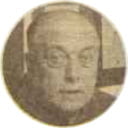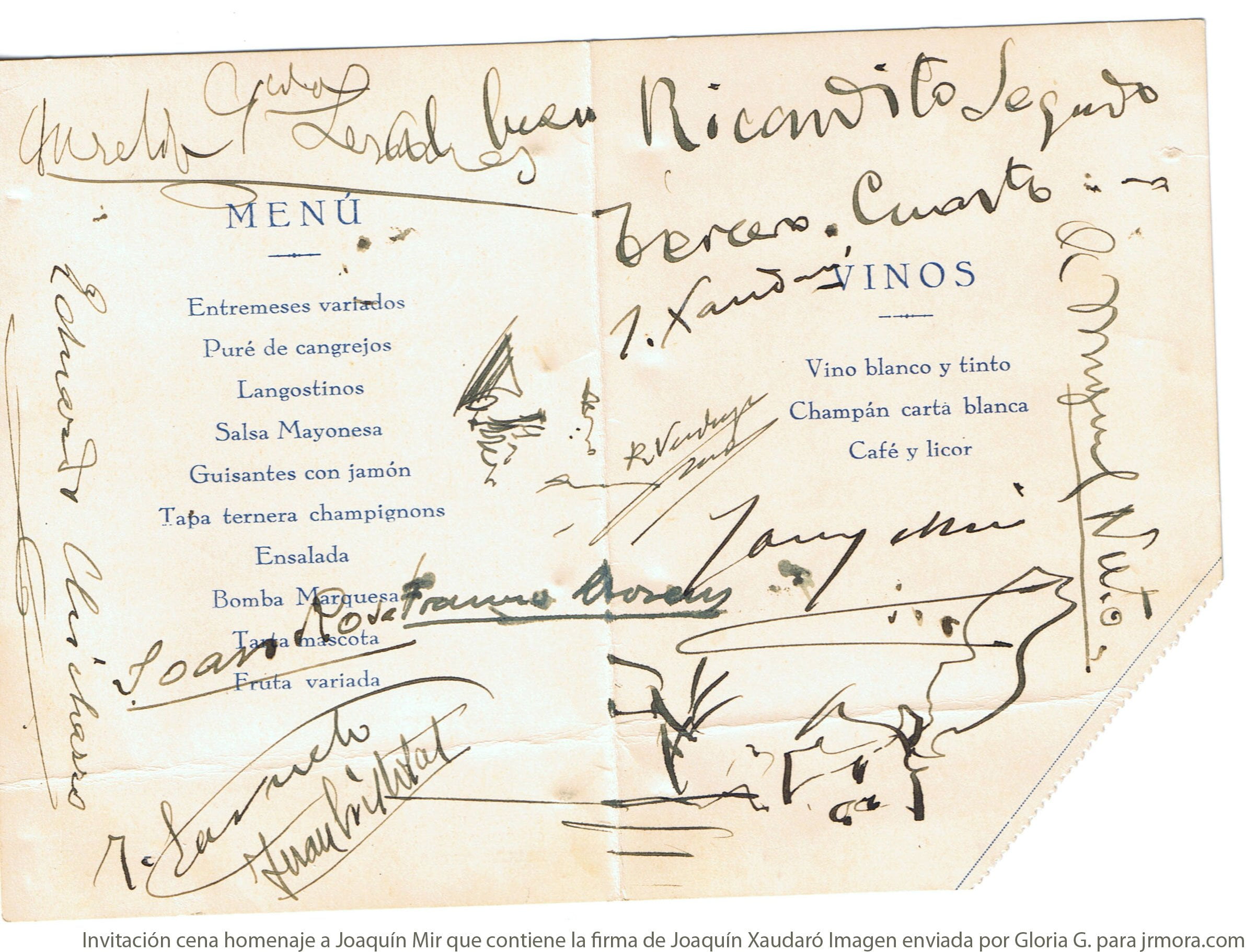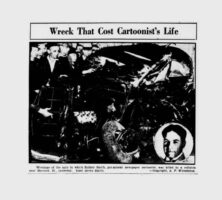
Today I have received a comment that I have rescued as an excuse to turn it into a call, lending a hand is free and can help us to recover some more information about this cartoonist who published in the magazine Blanco y Negro and worked in the newspaper ABC, a brilliant cartoonist to whom many believe "artistic" justice has not been done
If you think you can help Javier (author of the comment/request) in his search, you can leave any information you consider interesting right here. Javier Rodríguez Lázaro is looking for information about his biography, at least today I was able to find the name of the street where he spent the last minutes of his life, that's something.
I am doing a little research on a 19th century civil engineer (Celso Xaudaró) who, I believe, was the uncle and tutor of the cartoonist Joaquín Xaudaró. According to what I have been able to read in a brief biography of the cartoonist, "when he lost his father in 1877, he was taken in by his uncle, a civil engineer, in whose studio he devoted himself almost entirely to line and topographical drawing, but without abandoning caricature in his spare time"
I have looked for bibliography on Joaquín Xaudaró and, to my surprise, I have found hardly anything. Having found the reference to Luis Conde's book on graphic humour in Spain on his website, it occurred to me that perhaps he could give me a hand by pointing me to some work (book, article,...) where I could find a detailed biography of Joaquín Xaudaró.
Pulling everything I had at hand I have written another short biography and I have added what I have found hoping that it is about this Joaquín and not another one...
*Doubt any of the information written here, it may contain errors carried over from the different sources. If you think you can rectify any of them or contribute something else, you are welcome to do so.
Born in Vigan , Philippines (when it was still Spanish), and moved with his family to Barcelona in 1883, of Aragonese origin, Xaudaró was educated in Paris and London. There he studied drawing. His beginnings on paper were in Barcelona Cómica, Madrid Cómico, La Saeta, Gedeón and other newspapers. He sometimes used the pseudonym J. O'Raudax. ("Xaudaró" spelled backwards) (other sources cite this alias without the J)
In September 1897 he began to edit and illustrate, together with Francisco Navarrete, the Barcelona magazine The Monigoty. List of Xaudaró's publications in the Biblioteca Nacional de España.

From 1907 to 1914 he drew for Le Rire (Paris) and illustrated stories for the publishers Ollendorf, Albert and Mericaut. As an illustrator he also worked on the volumes of Les conteurs joyeux (published in Paris)
In Spain he illustrated the famous "Viajes morrocotudos" by Juan Pérez Zúñiga and did a set design for "Madame Buterfly".

Cover of "Las fantasticas aventuras de Tito Y Yif" , editorial Hormiga de Oro, 192¿?, 19x21 cms, other covers and references to Xaudaró's works here.
Once in Madrid he drew for Blanco y Negro, although he was best known for his daily cartoon in ABC, in which a little dog always appeared among the characters. This little animal ended up being called by everyone"El perrito de Xaudaró" (Xaudaró's little dog).
In 1932 he created SEDA (Sociedad Española de Dibujos Animados) together with Ricardo García, who would later be joined by Francisco López Rubio, after Xauradó's premature death, although the dissolution of the society was already inexorable. Of the list of short cartoons made at that time, only a few isolated scenes remain of:
(Un drama en la costa, Xaudaró. 1933. El rata primero, K-Hito. 1933)

In the forties, animation began to experience a period of splendour, with more than a hundred short cartoons being produced in Spain. Download PDF with more info found in the Filmoteca Española.
His last work was this collaboration with Ricardo García K-Hito for an animated cartoon film. See PDF with references to this work
Joaquín Xaudaró, one of the pioneers of Spanish graphic humour, died on 1 April 1933.
Xaudaró's last collaboration, published in ABC on 24 March 1933:

More info at news of the death of Xaudaró in "70 years of ABC 1932-33" , download PDF.
Xaudaró, born in Vigan (Philippines) on 17 August 1872. He began to be known for his collaborations in "Barcelona Cómica" and "La Hormiga de Oro", although his name began to "sound" strongly in 1898, when he joined "Blanco y Negro", where he immediately achieved great popularity. The shining star of a great constellation of cartoonists and humourists - Ribas, Tobar, Penagos, Sileno, Sirio, Fresno, Robledano, Echea, Sancha, etc. - after a break in Paris and another in Catalonia, he returned to his work in "Prensa Española" (...) making a joke almost every day in ABC from 1921.
In 1929 he was appointed president of the Unión de Dibujantes Españoles (Union of Spanish Cartoonists). He also had a great passion for cinema and even worked on a cartoon story. But, above all, he was an extraordinary illustrator of works such as "Viajes morrocotudos", by Pérez Zúñiga. "Cuentos del otro jueves" and "Portugal en broma". "Prensa Española" published several volumes with the caricatures of this brilliant cartoonist who, at the height of his fame, when it was still possible to expect great fruits of his genius, died at his home in Calle de Viriato (?) on 1 April 1933.
Curiosity:
In this book entitled "Genios locos y picaros" by Manuel Martínez Pastor, a curious anecdote is told about Enrique Xaudaró, nephew of Joaquín Xaudaró
"It was in the twenties of the last century, among the right wing. Novais introduced me to him and he was our capitalist partner in the start-up of the television series on forgotten Spanish traditions. He must have been born around 1907, of medium height, very probably dyed blond hair. By then he had acquired a certain notoriety, thanks to a swindle of which he was accused and for which he was condemned, with great repercussion induced from the power, in the press, known as the daily egg swindle"
Download PDF with the story about Enrique Xaudaró
Others:
Chapter 7 of the III volume of Alberto Insúa 's memoirs subtitled Love, travels and literature where Joaquín Xaudaró is quoted on several occasions (PDF)
*****
Other references and articles:
Landscape and landscape with a little dog as witness.
Joaquín Xaudaró (1872-1933) was fond of the "problem of the five dots": fitting a human figure so that the head and limbs correspond to five dots marked randomly on paper. Armed with Japanese paintbrushes, he captured his sometimes deliciously surreal humour in cartoons, strips and jokes, and in addition to the famous little dog, tramps, ugly women and "famous ghosts" featured in many of his works. On this page, some of the works published in "Blanco y Negro" and his first jokes in ABC.
His jokes still "work"
Text by Gallego & Rey
It is sad, but, today, hardly anyone remembers Xaudaró's little dog. However, in his time, the first decades of the 20th century, he was extraordinarily popular. He was more famous than Snoopy, Scooby-doo and the 101 Dalmatians put together. Of course, in those years, American colonisation had been geographically limited. You may think, as we do, that oblivion is logical because the vortex of time kills everything, and that is true, but in the prologue to the anthology of drawings by Joaquín Xaudaró published by Prensa Española in 1946, it is already stated that the appearance of the aforementioned work is due to the fact that "we are not resigned to his name remaining in oblivion".
Well, just a few years after the artist's disappearance, he has not only been forgotten, but... he is still forgotten!!!! That's the last straw. In this country of ungrateful amnesiacs they forget you as soon as you have the foolish idea of dying, and even much earlier, which is even worse.
Joaquín Xaudaró was born in the Philippines in 1872 and was an elegant guy, like his humour, and a good person, like his imaginary dog.
His work, based on a solid caricature of perfectly recognisable social types and painstaking drawing, although it has the candour of the works of that period, is not lacking in sharpness, mordacity and irony. His jokes, and this is the most important thing, still "work", as his modest colleagues say today.
Undoubtedly, the most personal discovery that brought him fame and fortune was his famous little dog, a character full of sympathy who constantly appeared in his drawings as a silent witness who, with looks and gestures, emphasised the situation.
It became like his signature. He became so important in the daily jokes that if the dog ever failed to appear, letters from readers poured into the editorial office demanding his immediate return.

Today, after seventy years, that unforgettable dog, who filled the lives of his contemporaries with smiles, returns to his home in the pages of ABC. We are proud to pay this tribute to its creator: Joaquín Xaudaró.
Source "One hundred years of ABC history (includes gallery of 14 vignettes of Xaudaró)"
Interview with Xaudaró
January 2014-José Ricardo March send this interview to Xaudaró published in the magazine "Caras y Caretas" (Buenos Aires) on 3 August 1929.
In it, in addition to a particular style of writing very much of the time, several curious anecdotes are discovered. One of them, very amusing, is about his most popular character, known as "el perrito de Xaudaró" (Xaudaró's little dog).
Related: Fluka has done a great job, he has scanned and published in his blog the complete story of "the fantastic adventures of Tito and Tif", 215 vignettes that you can read here.
Updated 09/06/2009:
Gloria G. sends this image (thank you very much!) of the invitation to the dinner tribute to Joaquín Mir attended by Joaquín Xaudaró and on which he stamped his signature(to the left of the word VINOS) and is next to those of other artists such as Ricardo Verdugo Landi, Anselmo Miguel Nieto, Garcia Lesmes, Juan Cristóbal, Ricardo Segundo Garcia and others. The event was held at the Círculo de Bellas Artes in 1930
Click to enlarge
Michelle, from France, sends a photo of the book she says she has in her collection : Les cincs points", the translation would be something like "The five points, the educational drawing for young and old" by J.Xaudaró with foreword by Achille Segard Ollendorff 1912 edition ( Merci beaucoup)
Click to enlarge

----------------------------------------------------------------------------------
Joaquín Xaudaró y Echau in Wikipedia
Other interesting links:
10 books by Xaudaró in the Hispanic Digital Library
Book. "J. Xaudaró's Jokes. Volume one, fourth edition (1960)
The dog of Xaudaró versus the dog of Urda
Xaudaró, baturro jokes
12 jokes about Xaudaró.










